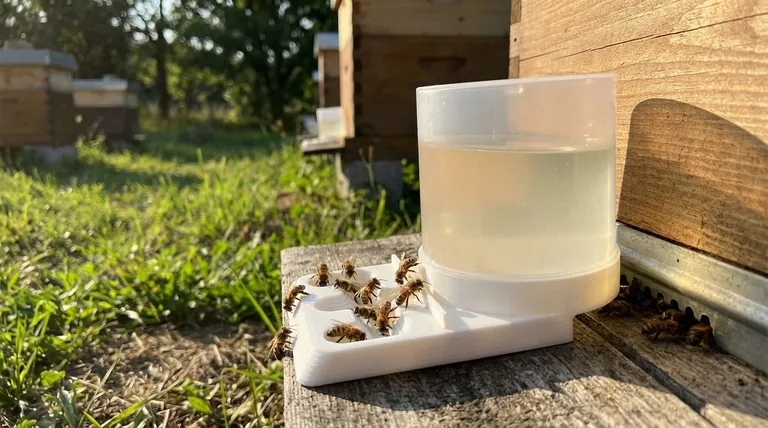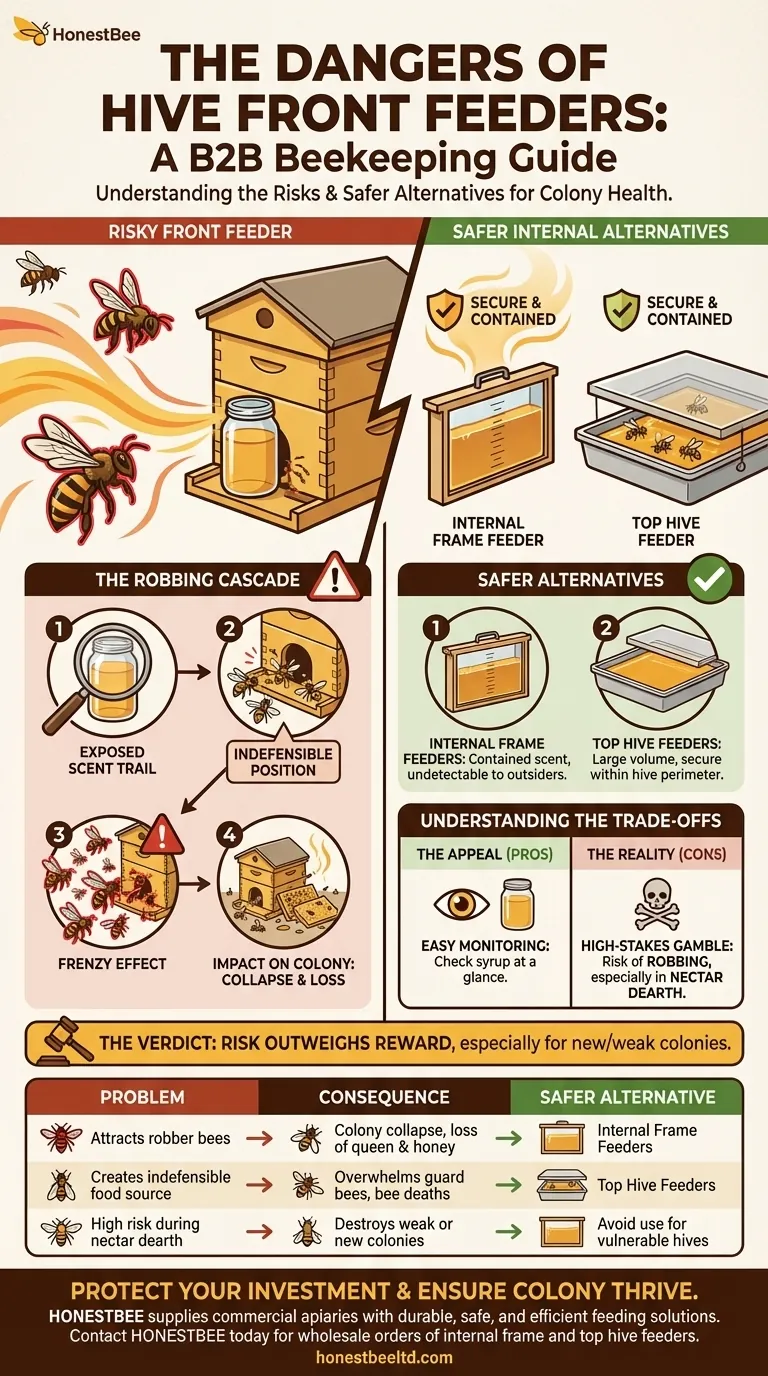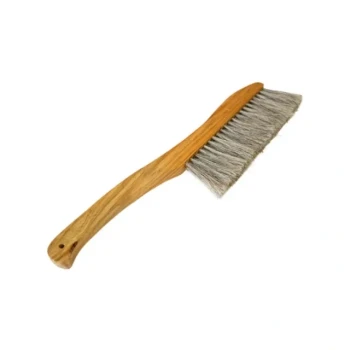The most common and dangerous problem with hive front feeders is their tendency to attract robber bees from other colonies. Because the sugar syrup is located outside the hive entrance, its scent acts as a powerful, open invitation that can easily trigger a "robbing frenzy," a catastrophic event that can destroy a weak or new hive.
While hive front feeders offer the convenience of easy monitoring, they create an external food source that is incredibly difficult for a colony to defend. This design flaw makes them the highest-risk feeding method, especially during periods when natural nectar is scarce.

The Robbing Cascade: Why Front Feeders are Risky
When you use a hive front feeder, you are essentially placing a "free food" sign right at the entrance of your colony's home. This creates a predictable and disastrous chain of events.
The Exposed Scent Trail
Unlike internal feeders, the scent of the sugar syrup from a front feeder is broadcast into the open air. Foraging bees from neighboring hives, which can fly for miles in search of food, can easily detect this concentrated and unnatural food source.
An Indefensible Position
The hive's guard bees are tasked with protecting the entrance. A front feeder forces them to defend a wide, external area against intruders. This is a much more difficult task than defending a small, internal entrance, and they are often easily overwhelmed by determined robber bees.
The Frenzy Effect
Once one or two robber bees successfully access the syrup, they return to their own hive and perform recruitment dances. This alerts hundreds, then thousands, of their hive mates to the easy target. The situation rapidly escalates into a full-blown robbing frenzy.
The Impact on the Colony
A robbing frenzy is violent and destructive. The invading bees will not only steal all the syrup but will also invade the hive itself to steal honey stores. This chaos often results in the death of the defending bees, the brood, and even the queen, leading to the complete collapse of the colony.
Understanding the Trade-offs
Every piece of beekeeping equipment has pros and cons. The convenience offered by front feeders comes at a steep, and often unacceptable, price.
The Appeal: Easy Monitoring
The primary benefit of a hive front feeder is the ability to check the syrup level at a glance without opening the hive. This minimizes disturbance to the colony, which is an attractive feature for many beekeepers.
The Reality: A High-Stakes Gamble
This convenience, however, is overshadowed by the immense risk of inciting robbing. This is particularly true during a nectar dearth—periods in late summer or fall when natural flower resources are scarce and bees are desperately searching for any available food source.
The Verdict: Risk Outweighs Reward
For new, small, or weak colonies, the risk is almost never worth the reward. These colonies lack the population of guard bees necessary to defend against even a small number of robbers, making them exceptionally vulnerable.
Safer Alternatives to Front Feeders
Protecting your hive from robbing is a core responsibility of the beekeeper. Fortunately, several other feeder types solve the core problem created by front feeders by moving the food source inside the hive.
Internal Frame Feeders
These feeders are designed like a brood frame and take the place of one or two frames inside the hive box. The syrup is contained entirely within the hive, making the scent undetectable to outsiders and allowing the bees to access it in a secure location.
Top Hive Feeders
A top feeder sits on top of the uppermost hive box, directly under the main cover. They hold a large volume of syrup and keep the food source well-contained within the hive's secure perimeter, making them a very safe and efficient option.
Making the Right Choice for Your Goal
Your choice of feeder should be dictated by the strength of your colony and your primary goal.
- If you are establishing a new or weak colony: Avoid front feeders entirely. Use an internal frame feeder or a top hive feeder to provide food safely and protect the vulnerable colony.
- If you have a strong, established colony during a spring nectar flow: A front feeder could be used with extreme caution, but it is still not the recommended method due to the inherent risks.
- If your primary goal is colony safety and health: Internal frame feeders and top hive feeders are the superior choices, as they eliminate the primary risk of robbing associated with external feeding.
Ultimately, your role as a beekeeper is to support and protect your bees, and choosing a secure feeding method is one of the most critical decisions you can make.
Summary Table:
| Problem | Consequence | Safer Alternative |
|---|---|---|
| Attracts robber bees | Colony collapse, loss of queen and honey stores | Internal Frame Feeders |
| Creates an indefensible food source | Overwhelms guard bees, leads to bee deaths | Top Hive Feeders |
| High risk during nectar dearth | Destroys weak or new colonies | Avoid use for vulnerable hives |
Protect your investment and ensure your colonies thrive with the right equipment. HONESTBEE supplies commercial apiaries and beekeeping equipment distributors with durable, safe, and efficient feeding solutions, including internal frame and top hive feeders, through our wholesale-focused operations. Contact HONESTBEE today to discuss your apiary's needs and place your wholesale order.
Visual Guide

Related Products
- HONESTBEE Entrance Bee Feeder Professional Hive Nutrition Solution for Beekeeping
- Classic Boardman Entrance Bee Feeder Hive Front Feeding Solution
- Boardman Entrance Bee Feeder Durable Galvanized Steel and Wood Construction for Beekeeping
- HONESTBEE Entrance Bee Feeder Efficient Hive Front Liquid Feeding Solution for Beekeeping
- HONESTBEE Professional Entrance Bee Feeder Hive Nutrition Solution
People Also Ask
- How does the entrance feeder method work? A Guide to Simple But Risky Hive Feeding
- What are the common types of honey bee feeders? Choose the Right Feeder for Your Hive
- How is the mesh ladder and barrier installed in the feeder box? A Step-by-Step Guide to Prevent Bee Drowning
- Are entrance feeders good for bees? Prioritize Hive Health Over Convenience
- What is the best feeder for bees? Choose the Right Feeder for Your Hive's Success



















